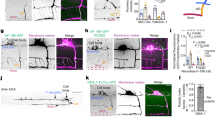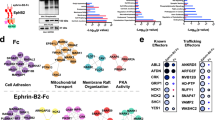Abstract
THE calcium-independent neural cell adhesion molecule N-CAM is expressed transiently during development in many tissues, including epithelia1. The three naturally occurring principal isoforms2,3 of N-CAM differ in the way in which they associate with the membrane and in their cytoplasmic domains4. These isoforms are generated by developmentally regulated alternative splicing of a single gene4–6: the large cytoplasmic domain (Id) form (relative molecular mass 180,000 (Mr 180K)) is specific for post-mitotic neurons; the 120K small cytoplasmic domain (ssd) and 140K small surface domain (sd) forms also occur on other cell types7. One function of the different isoforms could be to specify cellular localization; for example, glycosyl phosphatidyl inositol (GPI)-membrane anchoring acts as a targeting signal for expression on the apical surface of polarized epithelial cells8,9. Neurons and epithelial cells may use similar mechanisms for polarizing their plasma membrane proteins10,11. We have therefore investigated the targeting of GPI-anchored (ssd N-CAM, 120K) and transmembrane forms of N-CAM (sd N-CAM, 140K; Id N-CAM, 180K) by comparing the expression of each after transfection of the appropriate complementary DNAs into polarized epithelial cells. We find that isoforms with alternative modes of membrane association are targeted to different surfaces of polarized epithelial cells: ssd N-CAM is expressed on the apical surface, whereas sd and Id N-CAM are expressed on the basolateral surface. These results suggest that the different isoforms of N-CAM determine their own diverse cellular destinations. They also support the hypothesis that the GPI anchor acts as an apical targeting signal in epithelia.
This is a preview of subscription content, access via your institution
Access options
Subscribe to this journal
Receive 51 print issues and online access
$199.00 per year
only $3.90 per issue
Buy this article
- Purchase on Springer Link
- Instant access to full article PDF
Prices may be subject to local taxes which are calculated during checkout
Similar content being viewed by others
References
Edelman, G. M. A. Rev. Cell Biol. 2, 81–116 (1986).
Klein, G., Langegger, M., Goridis, C. & Ekblom, P. Development 102, 749–761 (1988).
Thiery, J.-P., Duband, J.-L., Rutishauser, U. & Edelman, G. M. Proc. natn. Acad. Sci. U.S.A. 70, 6737–6741 (1982).
Cunningham, B. A. et al. Science 236, 799–806 (1987).
Hemperly, J. J., Edelman, G. M., & Cunningham, B. A. Proc. natn. Acad. Sci. U.S.A. 83, 9822–9826 (1986).
Owens, G. C., Edelman, G. M. & Cunningham, B. A. Proc. natn. Acad. Sci. U.S.A. 84, 294–298 (1987).
Cunningham, B. A. & Edelman, G. M. in Morphoregulatory Molecules (eds Edelman, G. M., Cunningham, B. A. & Thiery, J.-P.) (Wiley, New York, 1990).
Lisanti, M., Caras, I. P., Davitz, M. A. & Rodriguez-Boulan, E. J. Cell Biol. 109, 2145–2156 (1989).
Lisanti, M. P. & Rodriguez-Boulan, E. Trends biochem. Sci. 15, 113–118 (1990).
Dotti, C. G. & Simons, K. Cell 62, 63–72 (1990).
Dotti, C. G., Parton, R. G. & Simons, K. Nature 349, 158–161 (1991).
Sargiacomo, M., Lisanti, M., Graeve, L., Le Bivic, A. & Rodriguez-Boulan, E. J. Memb. Biol. 107, 277–286 (1989).
Le Bivic, A., Sambuy, Y., Mostov, K. & Rodriguez-Boulan, E. J. Cell Biol. 110, 1533–1539 (1990).
Takeichi, M. A. Rev. Biochem. 59, 237–252 (1990).
Matsuzaki, F. et al. J. Cell Biol. 110, 1239–1252 (1990).
Mege, R.-M. et al. Proc. natn. Acad. Sci. U.S.A. 85, 7274–7278 (1988).
Nelson, W. J., Shore, E. M., Wang, A. Z. & Hammerton, R. W. J. Cell Biol. 110, 349–357 (1990).
McNeill, H., Ozawa, O., Kemler, R. & Nelson, W. J. Cell 62, 309–316 (1990).
Fleming, T. P. & Johnson, M. H. A. Rev. Cell Biol. 4, 459–485 (1988).
Pizzey, J. A., Rowett, L. H., Barton, C. H., Dickson, G. & Walsh, F. S. J. Cell Biol. 109, 3465–3476 (1989).
Pollerberg, G. E., Burridge, K., Krebs, K. E., Goodman, S. R. & Schachner, M. Cell Tissue Res. 250, 227–236 (1987).
Letourneau, P. C. & Shattuck, T. A. Development 105, 505–519 (1989).
Persohn, E., Pollerberg, G. E. & Schachner, M. J. comp. Neurol. 288, 92–100 (1989).
Moore, H-P. & Kelly, R. B. J. Cell Biol. 101, 1773–1781 (1985).
Murray, B. A., Hemperly, J. J., Prediger, E. A., Edelman, G. M. & Cunningham, B. A., J. Cell Biol. 102, 189–193 (1986).
Graham, F. & Van der Eb, A. Virology 52, 456–467 (1973).
Le Bivic, A., Real, F. X. & Rodriguez-Boulan, E. Proc. natn. Acad. Sci. U.S.A. 86, 9313–9317 (1989).
Author information
Authors and Affiliations
Rights and permissions
About this article
Cite this article
Powell, S., Cunningham, B., Edelman, G. et al. Targeting of transmembrane and GPI-anchored forms of N-CAM to opposite domains of a polarized epithelial cell. Nature 353, 76–77 (1991). https://doi.org/10.1038/353076a0
Received:
Accepted:
Issue Date:
DOI: https://doi.org/10.1038/353076a0
This article is cited by
-
Organization and execution of the epithelial polarity programme
Nature Reviews Molecular Cell Biology (2014)
-
ZIP2 and ZIP4 Mediate Age-Related Zinc Fluxes Across the Retinal Pigment Epithelium
Journal of Molecular Neuroscience (2012)
-
The epithelial polarity program: machineries involved and their hijacking by cancer
Oncogene (2008)
-
The role of carbonic anhydrases in renal physiology
Kidney International (2007)
-
Basolateral carbonic anhydrase IV in the proximal tubule is a glycosylphosphatidylinositol-anchored protein
Kidney International (2007)
Comments
By submitting a comment you agree to abide by our Terms and Community Guidelines. If you find something abusive or that does not comply with our terms or guidelines please flag it as inappropriate.



